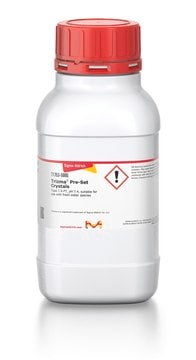T2194
Trizma® hydrochloride solution
pH 7.4, BioPerformance Certified, 1 M, suitable for cell culture
Synonym(s):
Tris hydrochloride solution
About This Item
Recommended Products
grade
BioPerformance Certified
for molecular biology
Quality Level
form
solution
concentration
1 M
technique(s)
cell culture | mammalian: suitable
impurities
DNase, RNase, Protease, none detected
bioburden, tested
endotoxin, tested
≤5 ppm Heavy metals (as Pb)
pH
7.4
useful pH range
7.0-9.0
absorption
≤0.05 at 290 at 40%
Looking for similar products? Visit Product Comparison Guide
General description
Application
Legal Information
Storage Class
10 - Combustible liquids
wgk_germany
WGK 3
flash_point_f
Not applicable
flash_point_c
Not applicable
ppe
Eyeshields, Gloves, type ABEK (EN14387) respirator filter
Certificates of Analysis (COA)
Search for Certificates of Analysis (COA) by entering the products Lot/Batch Number. Lot and Batch Numbers can be found on a product’s label following the words ‘Lot’ or ‘Batch’.
Need A Sample COA?
This is a sample Certificate of Analysis (COA) and may not represent a recently manufactured lot of this specific product.
Already Own This Product?
Find documentation for the products that you have recently purchased in the Document Library.
Customers Also Viewed
Related Content
Testing the Tech Article Page
Testing the category page
Our team of scientists has experience in all areas of research including Life Science, Material Science, Chemical Synthesis, Chromatography, Analytical and many others.
Contact Technical Service








